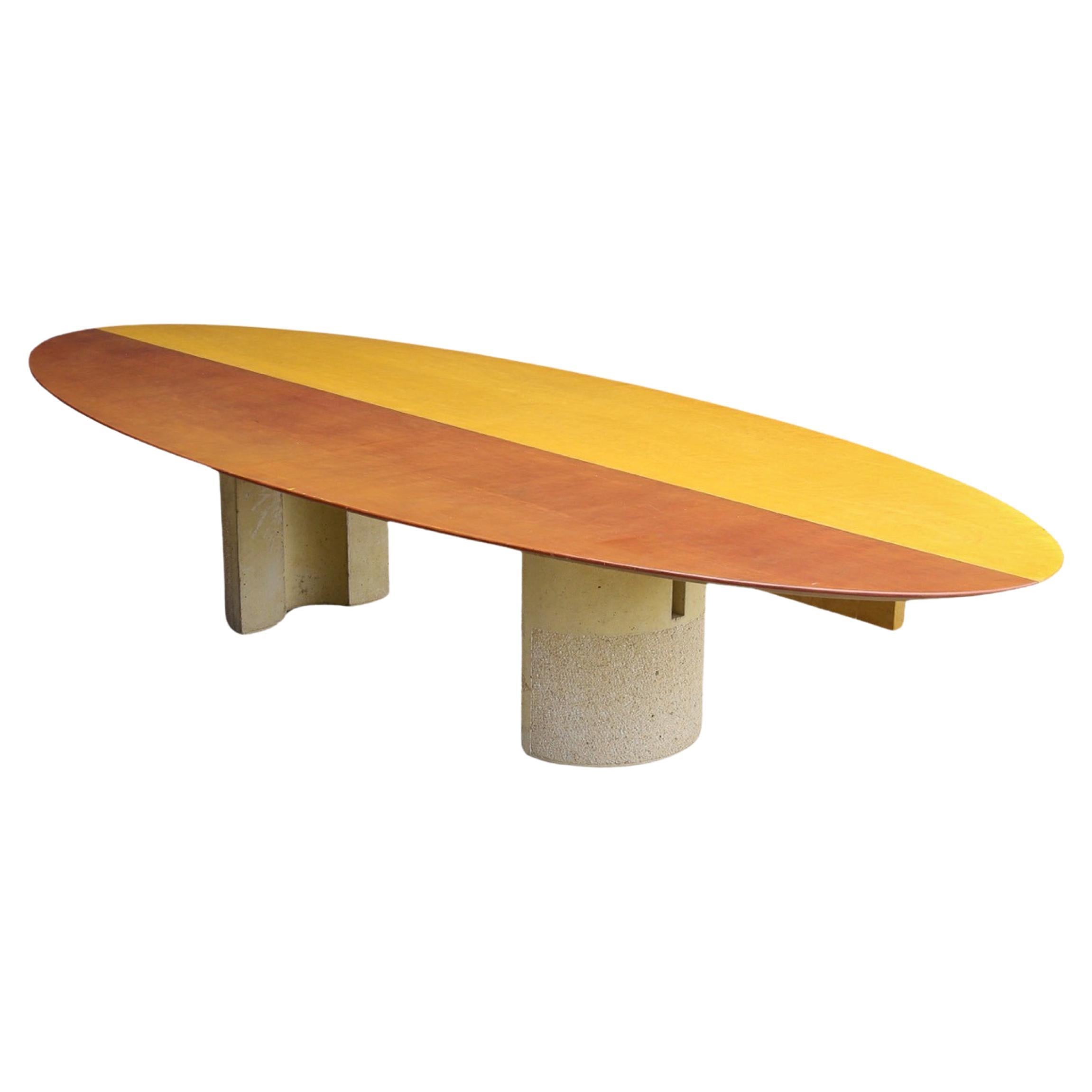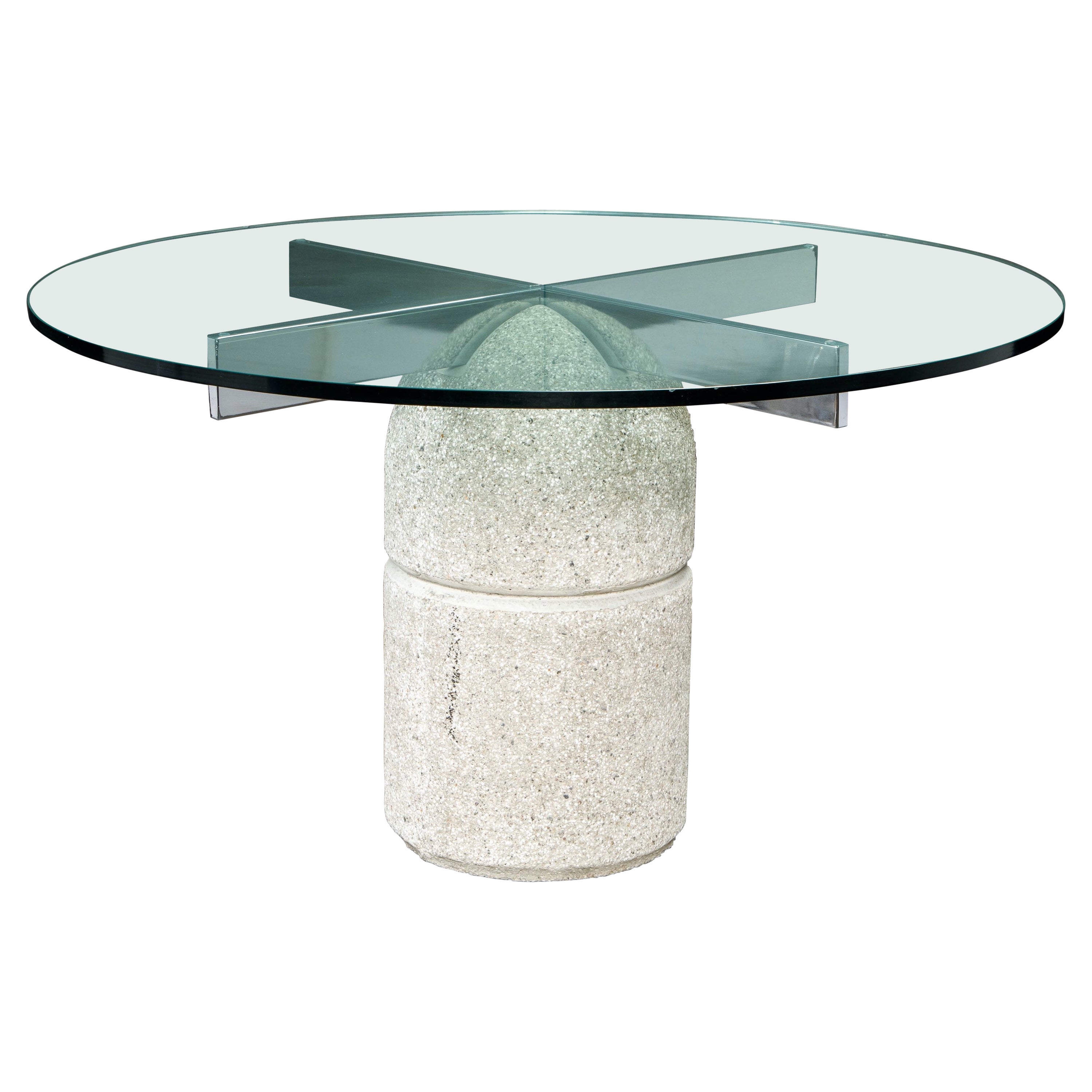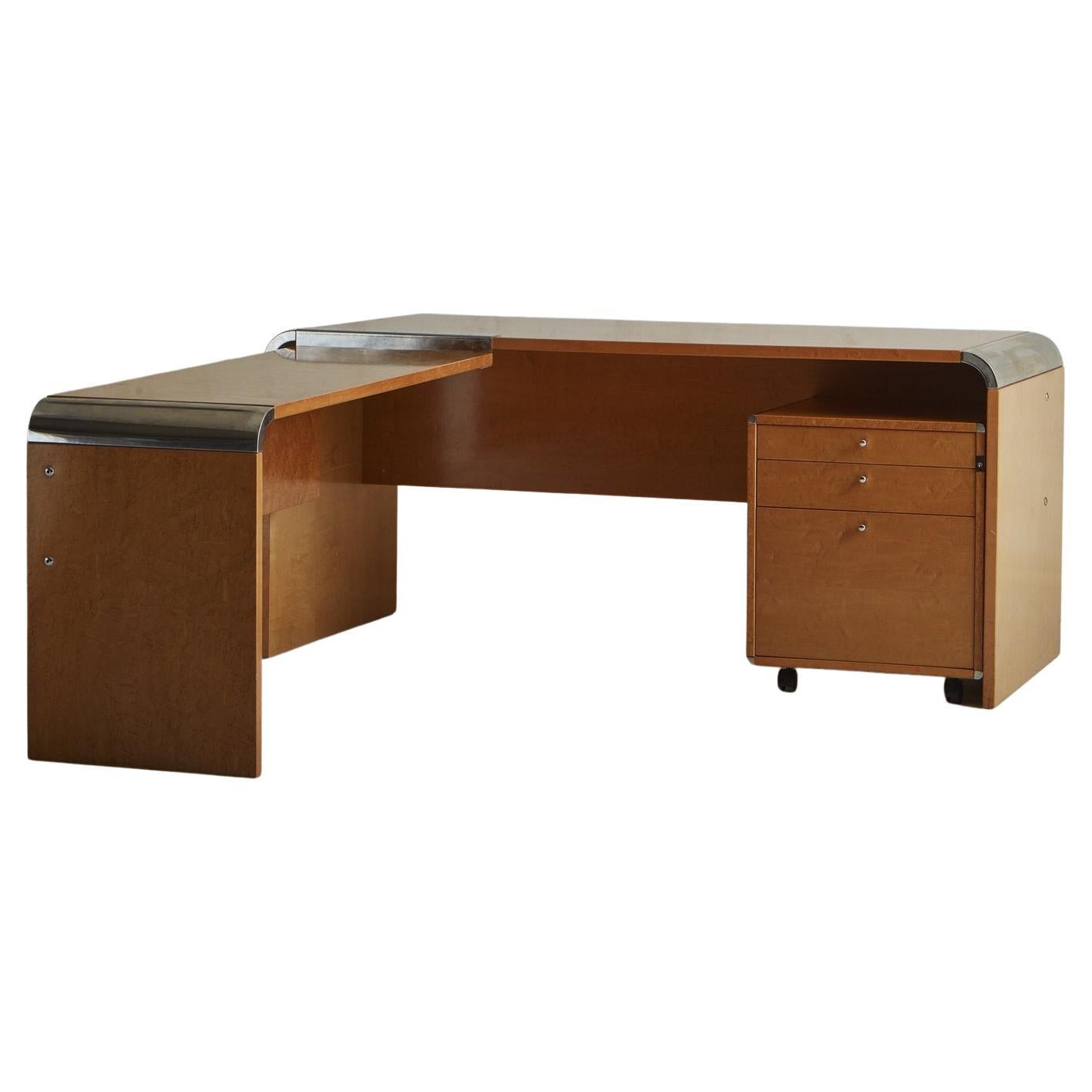Giovanni Offredi Sunny Round Pedestal Table in Wood and Glass by Saporiti 1970s
About the Item
- Creator:Giovanni Offredi (Designer),Saporiti (Manufacturer)
- Dimensions:Height: 28.35 in (72 cm)Diameter: 46.86 in (119 cm)
- Style:Post-Modern (Of the Period)
- Materials and Techniques:
- Place of Origin:
- Period:
- Date of Manufacture:1970
- Condition:Wear consistent with age and use.
- Seller Location:Montecatini Terme, IT
- Reference Number:1stDibs: LU5304220528632
Saporiti
Established initially as Fratelli Saporiti in 1950, mid-century Italian furniture maker Saporiti Italia has a reputation for avant-garde and enduring designs, and its tables, chairs and cabinets inspire all who have had the pleasure of contemplating them.
Furniture designer Sergio Saporiti founded Fratelli Saporiti with a vision of creating pieces ahead of their time. By staying on top of the cultural shifts taking shape during the postwar era — and finding inspiration in the craftsmanship, durability and sensibility of Scandinavian design — Saporiti was able to tap into what the public wanted. His focus on using high-quality materials ensured that every welcoming chair and table could be used and enjoyed for decades to come.
In 1965, Saporiti collaborated with Italian designer Alberto Rosselli, a pioneer of the industrial design movement. They created such iconic pieces as the Confidential sofa, the Moby Dick chaise lounge and the Jumbo chair. In the 1970s, Saporiti initiated another collaboration with Italian designer Giovanni Offredi. The prolific partnership resulted in universally renowned designs like the Paracarro table and the Sail chair. Together, they also created the curving Wave sofa, which was popular in international markets.
The joint projects were a success, and the brand opened many international showrooms throughout the 1970s. In the 1980s, the company officially rebranded as Saporiti Italia and released a line of customizable furniture, including the Avedon sofa, in collaboration with designer Mauro Lipparini. This era also led to a partnership with Missoni — the celebrated Italian fashion brand expanded into home furnishings in 1983 and created rugs and upholstery fabrics for Saporiti soon afterward.
Since then, Saporiti Italia has pivoted to furniture contracting and design management. To this day, the company remains under the ownership of the Saporiti family, and vintage Saporiti furniture continues to capture the imagination of collectors worldwide.
Find Saporiti Italia lounge chairs, coffee tables and sofas on 1stDibs.
- ShippingRetrieving quote...Ships From: Florence, Italy
- Return PolicyA return for this item may be initiated within 7 days of delivery.
- Vittorio Introini Oval Shaped Dining Table in Steel ang Glass by Saporiti 1970sBy Vittorio Introini, SaporitiLocated in Montecatini Terme, ITVery rare dining table with a beautiful base in steel and an oval-shaped top in thick glass, designed by Vittorio Introini and manufactured by Saporiti in 1970s. Vittorio Introini...Category
Vintage 1970s Italian Post-Modern Dining Room Tables
MaterialsSteel
- Vittorio Introini Chelsea Extendable Table in Walnut Wood by Saporiti 1960sBy Vittorio Introini, SaporitiLocated in Montecatini Terme, ITExtendable Chelsea dining table with a square tabletop and a pyramidal base entirely made in walnut wood and metal details. It was designed by Vittorio Introini and produced by S...Category
Vintage 1960s Italian Mid-Century Modern Dining Room Tables
MaterialsMetal
- Vico Magistretti Tema Square Table in Black Lacquered Wood by B&B 1970sBy B&B Italia, Vico MagistrettiLocated in Montecatini Terme, ITSquare table model Tema with structure in black lacquered wood and diagonal inserts in natural spruce on top. Designed by Vico Magistretti and produced by B&B, 1973, Italy. Lict...Category
Vintage 1970s Italian Mid-Century Modern Dining Room Tables
MaterialsWood, Spruce
- Franco Albini TL30 Round Table in Metal and Wood for Poggi Pavia 1950s ItalyBy Franco Albini, PoggiLocated in Montecatini Terme, ITRound table model TL30 with black lacquered metal base and a wooden top. Designed by Franco Albini for Poggi, Pavia in 1950s. After spending his childhood and part of his youth in Robbiate in Brianza, where he was born in 1905, Franco Albini moved with his family to Milan. Here he enrolled in the Faculty of Architecture of the Polytechnic and graduated in 1929. He starts his professional activity in the studio of Gio Ponti and Emilio Lancia, with whom he collaborates for three years. He probably had his first international contacts here In those three years, the works carried out are admittedly of a twentieth-century imprint. It was the meeting with Edoardo Persico that marked a clear turning point towards rationalism and the rapprochement with the group of editors of “Casabella”. The new phase that that meeting provoked starts with the opening of the first professional studio in via Panizza with Renato Camus and Giancarlo Palanti. The group of architects began to deal with public housing by participating in the competition for the Baracca neighborhood in San Siro in 1932 and then creating the Ifacp neighborhoods: Fabio Filzi (1936/38), Gabriele D’Annunzio and Ettore Ponti (1939). Also in those years Albini worked on his first villa Pestarini. But it is above all in the context of the exhibitions that the Milanese master experiments his compromise between that “rigor and poetic fantasy” coining the elements that will be a recurring theme in all the declinations of his work – architecture, interiors, design pieces . The opening in 1933 of the new headquarters of the Triennale in Milan, in the Palazzo dell’Arte, becomes an important opportunity to express the strong innovative character of rationalist thought, a gym in which to freely experiment with new materials and new solutions, but above all a “method”. Together with Giancarlo Palanti, Albini on the occasion of the V Triennale di Milano sets up the steel structure house, for which he also designs the ‘furniture. At the subsequent Triennale of 1936, marked by the untimely death of Persico, together with a group of young designers gathered by Pagano in the previous edition of 1933, Franco Albini takes care of the preparation of the exhibition of the house, in which the furniture of three types of accommodation. The staging of Stanza per un uomo, at that same Triennale, allows us to understand the acute and ironic approach that is part of Albini, as a man and as a designer: the theme addressed is that of the existenzminimum and the reference of the project is to the fascist myth of the athletic and sporty man, but it is also a way to reflect on low-cost housing, the reduction of surfaces to a minimum and respect for the way of living. In that same year Albini and Romano designed the Ancient Italian Goldsmith’s Exhibition: vertical uprights, simple linear rods, design the space. A theme, that of the “flagpole”, which seems to be the center of the evolution of his production and creative process. The concept is reworked over time, with the technique of decomposition and recomposition typical of Albinian planning: in the setting up of the Scipio Exhibition and of contemporary drawings (1941) the tapered flagpoles, on which the paintings and display cases are hung, are supported by a grid of steel cables; in the Vanzetti stand (1942) they take on the V shape; in the Olivetti store in Paris (1956) the uprights in polished mahogany support the shelves for displaying typewriters and calculators. The reflection on this theme arises from the desire to interpret the architectural space, to read it through the use of a grid, to introduce the third dimension, the vertical one, while maintaining a sense of lightness and transparency. The flagpole is found, however, also in areas other than the exhibition ones. In the apartments he designed, it is used as a pivot on which the paintings can be suspended and rotated to allow different points of view, but at the same time as an element capable of dividing spaces. The Veliero bookcase...Category
Vintage 1950s Italian Mid-Century Modern Dining Room Tables
MaterialsMetal
- Luigi Saccardo UFO Pedestal Table in Steel and Glass by Maison Jansen 1970sBy Maison Jansen, Luigi SaccardoLocated in Montecatini Terme, ITRound pedestal dining table model UFO with a base in brushed steel and tabletop in thick glass with a black enamel decorative circle. Designed by Luigi Saccardo and manufactured by Maison Jansen in the 1970s. Maison Jansen was a Paris-based interior decoration office founded in 1880 by Dutch-born Jean-Henri Jansen. From its beginnings, Maison Jansen combined traditional furnishings with influences of new trends including Anglo-Japanese style, the Arts and Crafts movement, and Turkish style. The firm paid great attention to historical research with which it attempted to balance clients' desires for livable, usable, and often dramatic space. Within ten years the firm had become a major purchaser of European antiques, and by 1890 had established an antique gallery as a separate firm that acquired and sold antiques to Jansen's clients and its competitors as well. In the early 1920s Jean-Henri Jansen approached Stéphane Boudin, who was then working in the textile trimming business owned by his father and brought him on board. Accounts of the arrangement vary. Speculation existed that Boudin was able to provide financial solvency to the prominent but capital-poor atelier. Boudin's attention to detail, concern for historical accuracy, and ability to create dramatic and memorable spaces brought increasing new work to the firm. Boudin was made director and presided over an expansion of the firm's offices and income. Not originally equipped with its own workrooms for producing furniture the firm began by relying upon antiques and the furniture contracted to outside cabinetmakers. By the early 1890s Maison Jansen had established its own manufacturing capacity producing furniture of contemporary design, as well as reproductions, primarily in the Louis XIV, Louis XVI, Directoire, and Empire styles. Throughout the firm's history, it employed a traditional style drawing upon European design, but influence of contemporary trends including the Vienna Secession, Modernism, and Art Deco has also appeared in Jansen interiors and in much of the custom furniture the firm produced between 1920 and 1950. Under Boudin's leadership, Maison Jansen provided services to the royal families of Belgium, Iran, and Serbia; Elsie de Wolfe, and Lady Olive Baillie's Leeds Castle...Category
Vintage 1970s French Mid-Century Modern Pedestals
MaterialsSteel, Iron
- Ettore Sottsass Dining Table in Wood and Black Lacquered Metal by Poltronova 50sBy Poltronova, Ettore SottsassLocated in Montecatini Terme, ITRound dining table or living room table with four legs in black lacquered metal, table top in wood and brass details. The peculiar tabletop presents a beautiful decoration due to t...Category
Vintage 1950s Italian Mid-Century Modern Dining Room Tables
MaterialsMetal, Brass
- Giovanni Offredi Dining Table for Saporiti, 1970sBy Giovanni Offredi, SaporitiLocated in HEVERLEE, BEConcrete and metal center or dining table designed by Giovanni Offredi for Saporiti Italy model 'Paracarro'. The table comes with its original squared with rounded edges table...Category
Vintage 1970s Italian Brutalist Dining Room Tables
MaterialsConcrete
- Paracarro table, Giovanni Offredi, Saporiti, Italy, 1970sBy Saporiti, Giovanni OffrediLocated in La Tour-de-Peilz, CHResulting from the fruitful and long collaboration between the talented Italian designer Giovanni Offredi and the furniture manufacturer Sergio Saporiti, this Paracarro table made in...Category
Late 20th Century Italian Modern Dining Room Tables
MaterialsConcrete, Cement, Steel, Chrome
- Dining Table by Giovanni Offredi for Saporiti Italia 1970sBy Giovanni Offredi, SaporitiLocated in Byron Bay, NSWThis awesome table with concrete legs and wooden top was designed by Giovanni Offredi per Saporiti in the 70s. By balancing perfectly the sculptural feeling of the concrete with the ...Category
Vintage 1970s Italian Mid-Century Modern Dining Room Tables
MaterialsConcrete
- 'Paracarro' Concrete Dining Table by Giovanni Offredi for Saporiti Italia, 1970sBy Giovanni Offredi, SaporitiLocated in Los Angeles, CAThis sleek modern 'Paracarro' dining table by Giovanni Offredi for Saporiti Italia was sculpted from concrete and chromed steel during the 1970s in Italy. A .75" thick and 50" diameter glass top adorns this stylish table which works great for dinners, games, meetings and as a center table and suitable for indoor or outdoor applications. Great for collectors and interior designers, using...Category
Vintage 1970s Italian Modern Dining Room Tables
MaterialsConcrete, Steel, Chrome
- Customized 'Paracarro' Dining Table Bases by Giovanni Offredi for Saporiti 1970sBy Giovanni Offredi, SaporitiLocated in Los Angeles, CAThis pair of customized 'Paracarro' dining table bases are originally by Giovanni Offredi for Saporiti Italia which are sculpted from concrete and chromed steel during the 1970s in I...Category
Vintage 1970s Italian Modern Dining Room Tables
MaterialsConcrete, Steel, Chrome
- Maple + Aluminum Desk by Giovanni Offredi for Saporiti, Italy, 1970sBy Giovanni Offredi, SaporitiLocated in Chicago, ILA rare Italian desk unit designed by Giovanni Offredi for Saporiti in the 1970s. This desk has one main section with an additional table top attachment, creating an L-shape. It was constructed with wood and has a maple wood veneer with an exquisite birdseye grain. This piece features brushed aluminum connectors and has an additional rolling modular cabinet with three drawers, which can be placed below or beside the desk. The top drawer has a cream acrylic insert organizer with five compartments. Unmarked. Sourced in Italy, 1970s. Dimensions: 61"W x 28.75"D x 28"H; extended piece 47"W x 17.75"D x 28"H Giovanni Offredi (1927-2007) was a prominent Italian furniture and product designer recognized for his use of angular lines and exposed wood or metal frames. He began making furniture for the wealthy elite of Milan...Category
Vintage 1970s Italian Mid-Century Modern Desks and Writing Tables
MaterialsAluminum






